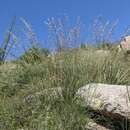Comprehensive Description
provided by North American Flora
Bouteloua eludens D. Griff. Contr. U. S. Nat. Herb
14:401. 1912.
Pereimial; culms densely tufted, erect, 25-70 cm. tall; sheaths glabrous, the lower ones crowded, the upper ones shorter than the internodes; blades firm, flat, attenuate, somewhat flexuous, 5-15 cm. long, 1-2.5 mm. wide, glabrous or pilose on the upper surface, the margins scabrous; spikes 10-15, about 1 cm. long, roughly triangular, spreading or drooping, falling entire, the rachis ciliate; spikelets 3-6, crowded; glumes acuminate, hirsute, the first narrow, about 5 mm. long, the second broader, 7-8 ram. long; lemma 6-7 mm. long, 3-toothed, glabrous on the lower part of the back, hairy on the margins and toward the summit; second floret often staminate, with 4 slender teeth, awned from between the teeth, the awns flattened, stout, hairy, 5-6 mm. long; a rudimentary floret, similar to the second but much reduced, often developed.
Typb locality: Santa Rita Mountains, Arizona {.Griffiths 7269).
Distribution: Rocky hills, southern Arizona and Sonora.
- bibliographic citation
- Albert Spear Hitchcock, Jason Richard Swallen, Agnes Chase. 1939. (POALES); POACEAE (pars). North American flora. vol 17(8). New York Botanical Garden, New York, NY
Physical Description
provided by USDA PLANTS text
Perennials, Terrestrial, not aquatic, Stems nodes swollen or brittle, Stems erect or ascending, Stems caespitose, tufted, or clustered, Stems terete, round in cross section, or polygonal, Stem internodes hol low, Stems with inflorescence less than 1 m tall, Stems, culms, or scapes exceeding basal leaves, Leaves mostly basal, below middle of stem, Leaves conspicuously 2-ranked, distichous, Leaves sheathing at base, Leaf sheath mostly open, or loose, Leaf sheath smooth, glabrous, Leaf sheath hairy at summit, throat, or collar, Leaf sheath and blade differentiated, Leaf blades linear, Leaf blades very narrow or filiform, less than 2 mm wide, Leaf blades 2-10 mm wide, Leaf blades mostly flat, Leaf blades mostly glabrous, Leaf blades more or less hairy, Leaf blades scabrous, roughened, or wrinkled, Ligule present, Ligule an unfringed eciliate membrane, Inflorescence terminal, Inflorescence with 2 or more spikes, fascicles, glomerules, heads, or clusters per culm, Inflorescence a panicle with narrowly racemose or spicate branches, Inflorescence branches more than 10 to numerous, Inflorescence branches 1-sided, Inflorescence branches terminating in bristle or point, Rachis angular, Flo wers bisexual, Spikelets sessile or subsessile, Spikelets laterally compressed, Spikelet less than 3 mm wide, Spikelets with 1 fertile floret, Spikelets solitary at rachis nodes, Spikelets all alike and fertille, Spikelets bisexual, Spikelets falling with parts of disarticulating rachis or pedicel, Inflorescence branches deciduous, falling intact, Spikelets secund, in rows on one side of rachis, Rachilla or pedicel glabrous, Glumes present, empty bracts, Glumes 2 clearly present, Glumes equal or subequal, Glumes distinctly unequal, Glumes equal to or longer than adjacent lemma, Glume equal to or longer than spikelet, Glumes keeled or winged, Glumes 1 nerved, Lemma coriaceous, firmer or thicker in texture than the glumes, Lemma 3 nerved, Lemma body or surface hairy, Lemma apex dentate, 3-5 fid, Lemma teeth unequal. central tooth longer, Lemma awnless, Lemma mucronate, very shortly beaked or awned, less than 1-2 mm, Lemma margins thin, lying flat, Lemma straight, Lemma surface pilose, setose or bristly, Palea present, well developed, Palea membranous, hyaline, Palea shorter than lemma, Palea 2 nerved or 2 keeled, Stamens 3, Styles 2-fid, deeply 2-branched, Stigmas 2, Fruit - caryopsis.
Bouteloua eludens: Brief Summary
provided by wikipedia EN
Bouteloua eludens, colloquially known as Santa Rita grama or sometimes Santa Rita Mountain grama, is a grass species in the grama genus native to southern Arizona in the United States and northern Sonora in Mexico.
- license
- cc-by-sa-3.0
- copyright
- Wikipedia authors and editors

